Meet 10 people who are making a difference in Kansas City
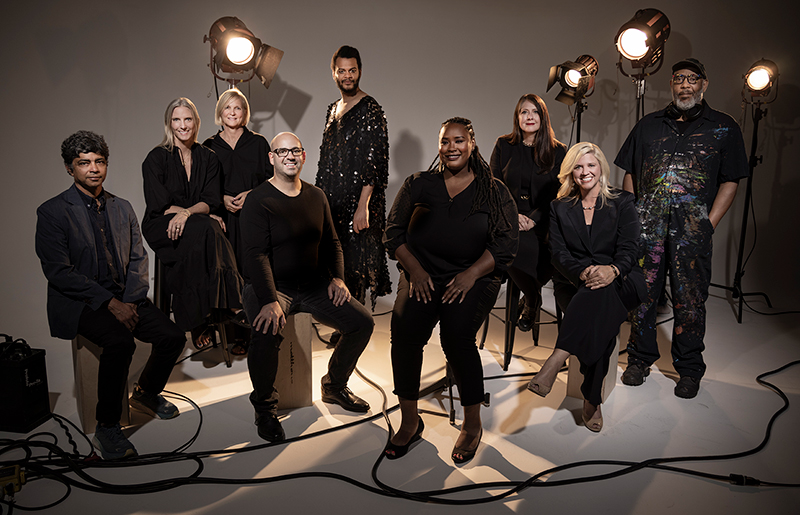
From fruit flies to racehorses, a bullied teenager, a nurse’s care, and a harp named Romeo. Those divergent elements are touchstones for a few of the individuals profiled in this year’s list of people you want to know.
But, as in years past, they have more in common than you may think. While just two of them are involved in the medical field, they’re all involved with the wellbeing of our community.
We offer a snapshot of each honoree along with answers to our question: How would you describe Kansas City to someone who’s never been here? Their answers reflect pride for what’s working well along with hopes for what can be better.
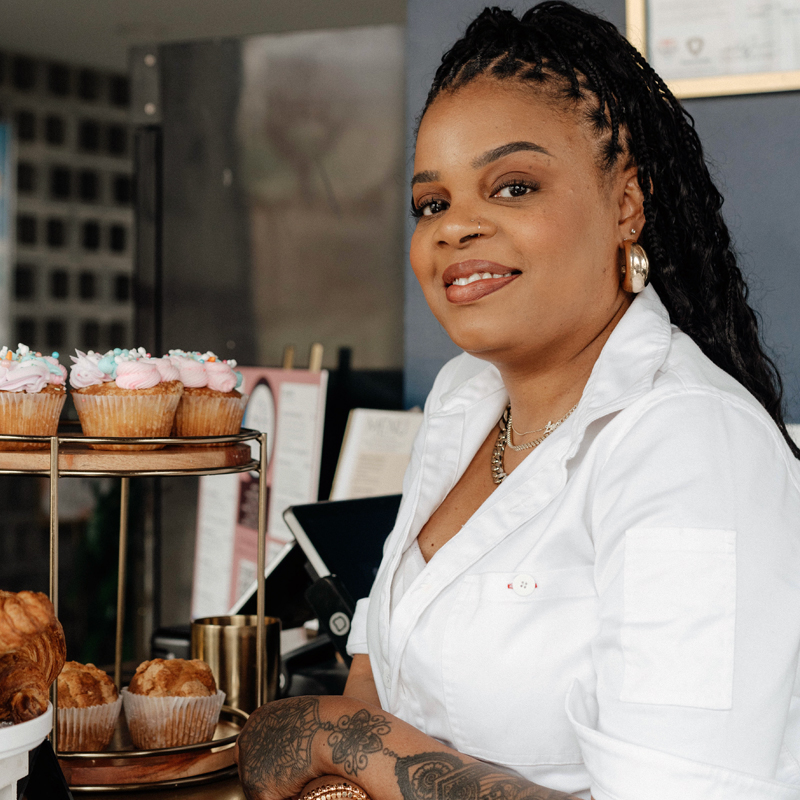
Food and Beverage
Shanita McAfee-Bryant
When people call Shanita McAfee-Bryant a role model, she deflects the description. “I want to make what I do more about the students and what they need from me.”
The Kansas City native opened The Prospect, a culinary training center, in 2019 to address food access, nutrition education, and job training in the Eastside area struggling with poverty.
Her own path in the food industry had its challenges. A teenage mom, she took classes at Johnson County Community College where Black female chefs were rare. She opened a restaurant and competed on The Food Network’s Cutthroat Kitchen, where her skills and personality got her noticed.
All the while, she counted on the support of her dad, her own hero, a man who had built a successful janitorial services company employing 300 workers. She learned a fierce work ethic from him. He passed away in 2018; a mural with his portrait is a reminder of his love and support.
She realizes not all of her students—whom she calls Prospects—are blessed with the kind of encouragement she got from her dad. So, she and her team work extra hard to provide that sometimes tough love. “We tell them that if you’re willing to work hard, you can make it. But it’s not easy.”
“We can teach skills,” she says. “The gumption and passion are up to them. Some people don’t even know they have the grit necessary for this work; our job is to dig deep to bring it out.”
McAfee-Bryant has several examples of Prospects who have blossomed through the 16-week training. “I see a litany of barriers,” she says, “including difficulty reading. I didn’t know I had dyslexia as a kid. There wasn’t a name for it back then. Imagine following a recipe if you can’t comprehend the words.”
Addressing the whole person is baked into The Prospect’s philosophy. “We provide stress management training, social skills, financial and nutritional education, and career planning. We don’t just graduate our Prospects then kick them out of the nest. We stay connected, always asking ‘What do you need to be successful? Would social services or day care help?’”
The Prospect houses The Spot, a 1,200-square-foot culinary space featuring a café, coffeeshop, and grocery section that accepts SNAP benefits. Food is prepared by the Prospects to provide hands-on training. “They also participate in catering and special events, and frankly love to be out of the place to interact with other people all over town.”
Not that it’s not a comfortable place to be. The Prospect is in a handsome, renovated limestone building at 2000 Vine Street. The dining area has cozy sofas, long community tables, and an inviting vibe. On mornings, groups of customers hang out, savoring lattes and croissant breakfast sandwiches or popping in for pastries for the office. Next door is Vine Street Brewing, Kansas City’s first Black-owned brewery.
When describing her hometown, McAfee-Bryant says “It’s emerging. We’re finally letting go of our identity just tied to barbecue. And there’s a wealth of culinary talent here; you don’t have to go to the East or West Coasts to gain recognition.”
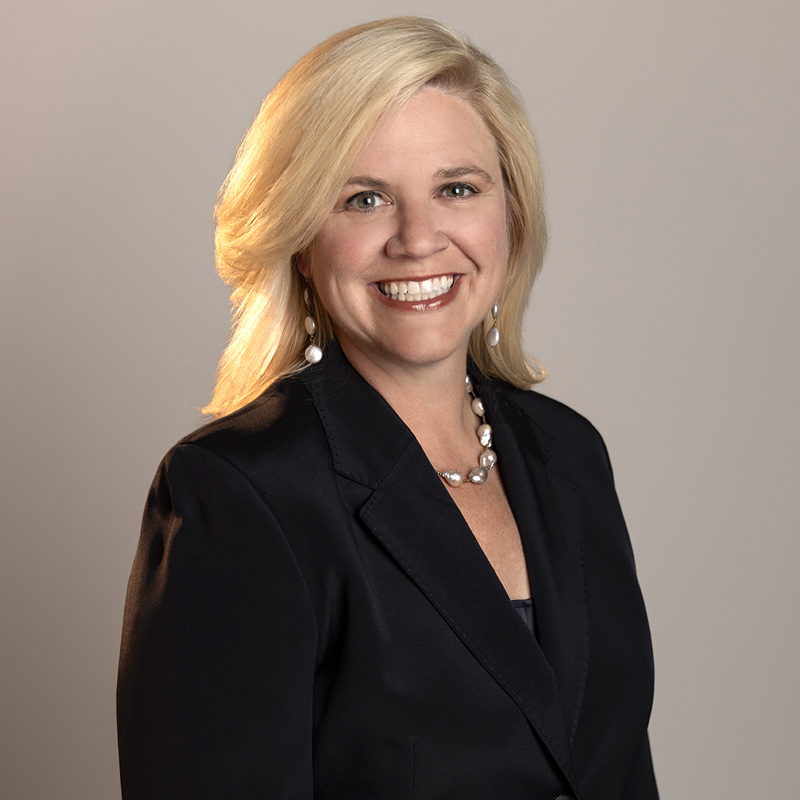
Entrepreneurship
Ashley McClellan
Ask any nurse why he or she chose their profession and chances are the first answer will be, “I want to help people.” It most assuredly won’t be, “I love doing paperwork.”
McClellan spent 20 years in leadership roles in the healthcare industry where she was struck by the staffing crisis. “It was a growing dilemma before, during, and after the pandemic,” she says. “Hospitals just didn’t have enough staff to care for patients safely.”
So, in 2023 she launched MedCurate, which uses an app to match nurses to available hospital shifts, giving the clinicians more flexibility while helping avoid burnout. “In doing so, we help these nurses stay in health care longer and reduce hospitals’ turnover.”
MedCurate, which McClellan compares to an Uber for healthcare, also can reduce hospitals’ expenses significantly. She says staffing can represent 85 percent of a hospital’s operating costs. “Our program can save about half the cost of traditional staffing agencies.”
And while McClellan initially thought the platform would appeal mostly to millennial-aged nurses simply because of their comfort level with technology, she’s been pleased to see the full spectrum of clinicians and providers coming on board. “These may be nurses at the end of their careers who are saying, ‘Maybe I don’t want to pick up three 12-hour shifts or work so many nights and holidays. I can pick up two 12s and won’t be tempted to leave the profession I love.’”
MedCurate started with one hospital and has now added a second one, as well as a surgery center and a home health company, with more growth on the horizon.
McClellan describes Kansas City as an engaging and innovative community that welcomes locals and travelers to experience the best the Midwest has to offer.
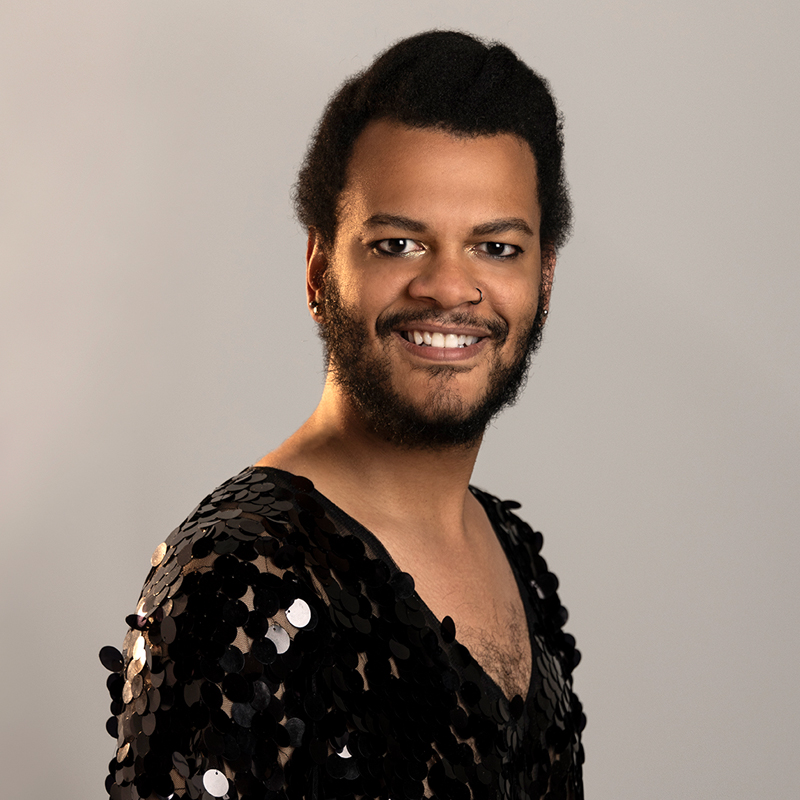
Music
Calvin Arsenia
Calvin Arsenia is in a good place—literally. The singer, songwriter, and author is the director of the Greenwood Social Club on the city’s Westside, a title he inherited from its founder, Peregrine Honig, last December. Arsenia shows reverence for the space that’s both cavernous and cozy. Sofas and floor pillows invite guests to relax and listen—really listen—to performers.
“I wanted to offer a place to play where you can hear a pin drop,” he says, “unlike restaurants and bars where music isn’t the main focus. These are often people who’ve devoted their careers to their craft. They deserve to be appreciated.” In this space he calls a shrine to art and beauty, Arsenia has hosted an eclectic mix of experiences, including yoga, tango, exotic dance, folk, indie rock, jazz, and tonal music.
As for his own style, it’s genre elusive. “Over the years I’ve tried on different phrases to try to describe my work, and it just doesn’t capture it. I just follow my bliss to where it takes me.” In early July, he’ll follow it to an arts and music fest in Scotland.
The first time he visited the country was on a missionary trip with his Kansas City church. Over two years, he began to perform during open mic nights, several times a week. “It was a freeing experience,” he recalls. “My background is from a choral and classical lens, so I had to figure out how to be authentic and make mistakes. I heard musicians who were technically perfect, but the ones I was drawn to were open to showing their vulnerability.” It was also there that he began lessons on the instrument he’s become known for, the Celtic harp.
In 2019, Arsenia raised $30,000 through gifts and donations to buy his own harp, which he named Romeo. “I was getting ready to perform at the Kennedy Center when the world shut down. So it was Romeo and me through the pandemic.”
During that time, Arsenia created a podcast with a friend, New York-based comedian Justin Randall. “I thought the world was ending, so I might as well be completely honest about being queer and growing up in the Evangelical church.” That led to his book of poetry, Every Good Boy is Fine, which he says is very intimate and sometimes embarrassing. “When we’re honest with our most scary thoughts, that’s when we learn that our emotions are universal.”
Whether Arsenia is performing music from his albums Cantaloupe, LA Sessions or his latest, Paradise, it’s a theatrical experience. “We live in a unique time where we can listen and learn and draw from so many sources both musically and stylistically and visually.”
How would he describe Kansas City? “What I tell people who haven’t been here is that it’s a lively, supportive community that’s welcoming to different areas of the arts. Midwest kindness goes a long way in Kansas City.”
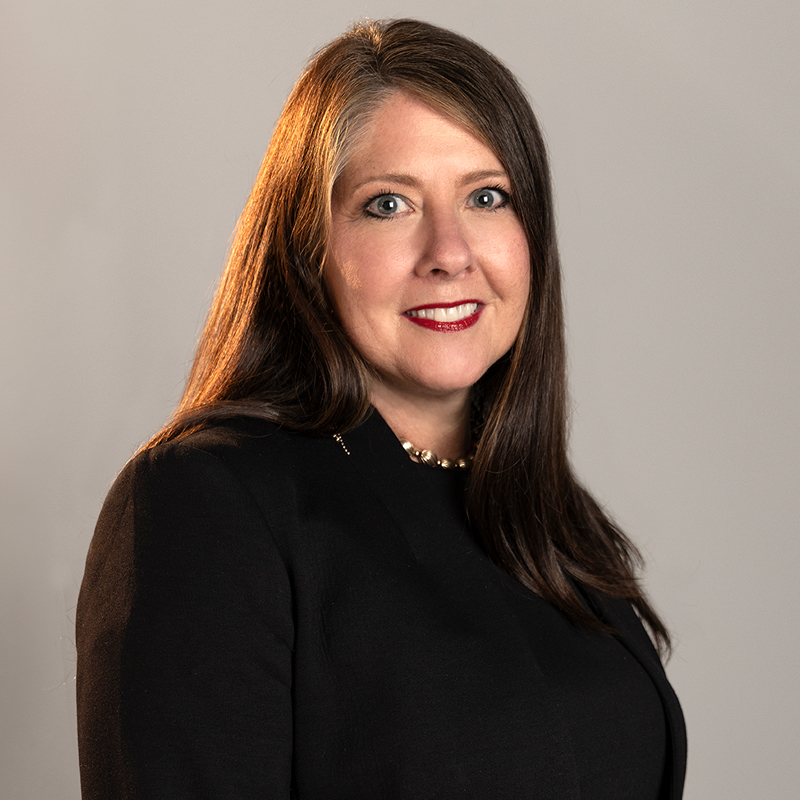
Architecture and Interior Design
Mason Paoli
Mason Paoli wears many hats in her role as an interior designer for a number of prestigious projects all over the world. Over the past few months, she switched from a stylish red Derby Day hat to a Stetson.
The different head gear reflects two of her most recent projects as the interior design director for Populous, a design firm headquartered in Kansas City.
Paoli has provided interior design direction for Churchill Downs for ten years. “But gearing up to the 150th anniversary of the Kentucky Derby was really special,” she says. “Horse racing is my favorite spectator sport. It combines fashion, sports and fun. It’s a party filled with history.”
This $200 million project reimagined the heart of the horse-racing center, the Paddock. “It’s where they bring in the horses, saddle up, and parade around. It’s such a big part of the two-day event.” The Populous team was tasked with peeling back many of the prior renovations to reveal the iconic twin spires. “It was transformative,” Paoli says. “Now patrons can experience the thrill taking place in the saddling stalls but horses aren’t bothered thanks to an expanse of two-way glass.”
Any project begins with intense listening. “Our approach isn’t based on my tastes or my ideas,” she says, “but what we can mine from the client. We ask, ‘how can we bring out the most special aspects from our clients’ stories?’ because that’s what makes each project unique.
“It’s all about making the experience memorable for the guest.” That wow factor came into play with the recently renovated BMO Centre in Calgary, Alberta, Canada. How do you make a convention center with one million square feet feel special to each guest whether they’re attending a business conference or the Calgary Stampede, the largest rodeo in the world? “We approach each project with curiosity, but this one took us on a more interesting journey than most,” she says. “It’s like a giant state fair with spaces that meld different cultures together; the Indigenous camps, the story of the stampede. It doesn’t look or feel like a typical convention center; it’s light and airy with wood accents, local art and a 70-feet tall fireplace made of blackened steel as a reference to a major area industry.
“The success of any design solution depends on the intimate human experience,” she says. “While we’re known for large-scale venues, we were thrilled to design a new prototype for Chicken N Pickle. The idea was to elevate the experience while capturing the spirit of the brand as they grow their business. And they’re growing like crazy.”
She treats all assignments the same whether it’s a $20 million or $500 million project: “It’s about a human being coming into a space and experiencing our design. You want people to come away remembering the connections they had with others in that environment.”
Paoli doesn’t have to go to Calgary or Kentucky to experience world-class entertainment. It’s right here in Kansas City, which she describes as “unexpected”. People from out of town are still surprised by our arts, food, and culture and our diverse neighborhoods. It’s a pillar of Midwestern values.”
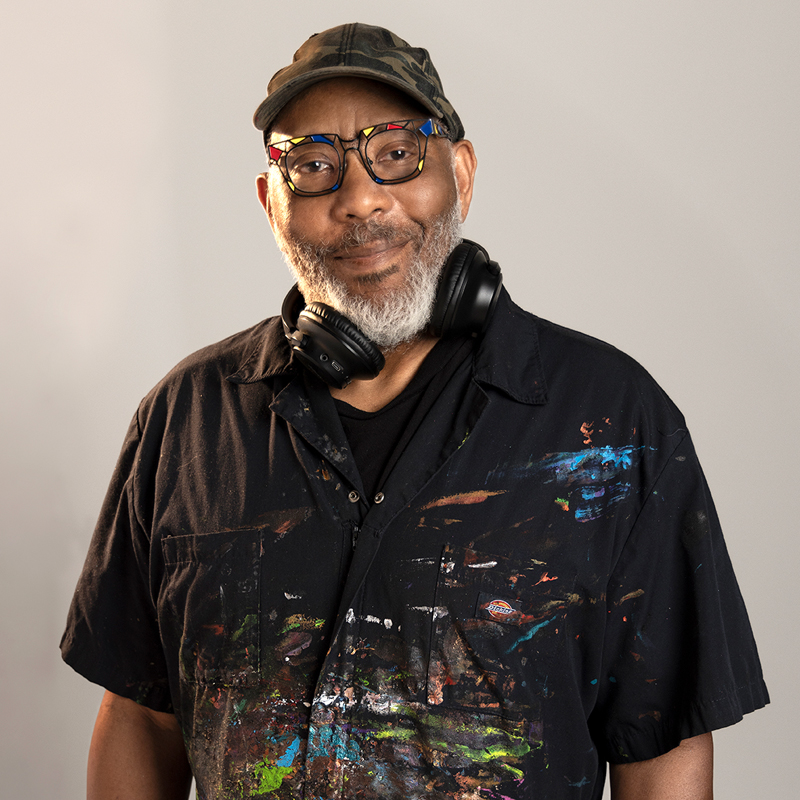
Arts
Harold Smith
Before it was sold, the painting on the wall outside Harold Smith’s space in Studios, Inc. in the East Crossroads served as a sort of shingle stating, “Art Sold Here.” Aggressive strokes of acrylics covered the 60-inch by 48-inch canvas, one of Harold’s 2022 Men of Color series. The eyes were haunted and haunting.
The painting reflects what the artist is best known for: powerful images of men and women, bold slashes of paint defining the features. In his Pain and Privilege series of collages, strips of newspapers bisect the faces: headlines of Martin Luther King’s assassination, illustrations of enslaved families.
It follows Smith’s own mantra and what he tells students and other artists: Do epic shit. “I don’t remember who said that, but the message is a resounding truth,” he says. “I tell other creatives starting out, ‘do you.’ If I can pick out who you’re trying to emulate, it’s time to start over and find your own unique voice.”
It’s been an evolution for him; his first exhibit was in the Kansas City, Kansas Library in 1999 and while the pieces were smaller with more details, they were clearly his. Nearly 25 years later, he just took down his Covers show at the Kansas City, Missouri Library. The work included faces with Art in America headings. Leather jackets feature faces as well: one is a grotesque image painted on top of a woman’s profile seen from the back. Victorian cameo meets the boogeyman. Bike helmets are decorated with CDs, nails, colors of dark purple and black, and glitter—an ode to his fascination with post-apocalyptic movies.
Every inch of his studio space is covered with stacked paintings or tubes of paint and cans filled with brushes. He admits he would drown if he didn’t have fellow artist and studio assistant Vivian Wilson-Bluett to organize things. “It’s a beautiful pool and she’s my lifeguard.”
He’s grateful to have the large quarters. Thanks to corporate and individual sponsors, Studios, Inc. provides space to mid-career artists for three years. Smith is in his third year with an extended period.
He’s planning an exhibition there in November, titled Blacktackular, described as an immersive experience with a glimpse into films that have influenced his work from the 70s to the 90s. Smith will host weekly movie nights beginning in October leading up to the event. “My goal is to entertain and draw people in, including those who’ve never imagined themselves at an art opening.”
To describe Kansas City, the artist says that unlike New York City, it’s a collection of small communities, each with its own flavor. “Westport, Zona Rosa, Rosedale; whatever you’re looking for, you can find it.”
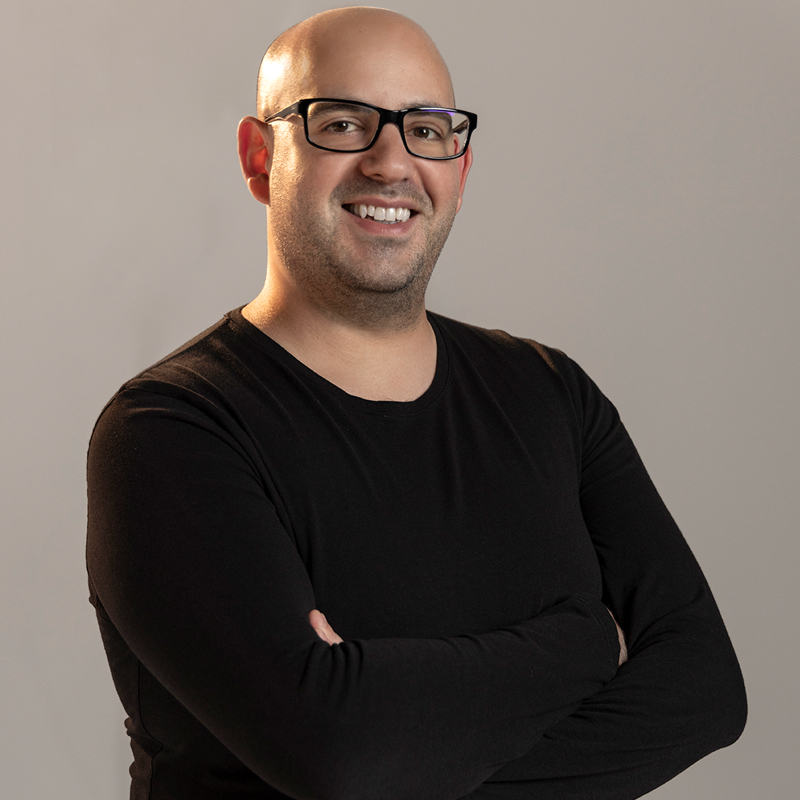
Literature
Adib Khorram
Adib Khorram’s life is an open book. His bio includes several of his interests, including figure skating and taking guitar lessons, activities that started when his editor said he needed a new hobby. “That conversation came about when I sold my first novel, Darius the Great is Not Okay, in 2018. Before that, writing was my hobby and now it was my job with a capital J.”
The book’s protagonist is a 15-year-old outsider, which mirrors Khorram’s identity as a gay, Iranian American male attending public schools in North Kansas City in the 80s, graduating in 2002. At that time in our country’s political history, the years were especially challenging for a kid whose family had immigrated from the Middle East.
“Add to that the normal life of a teenager. Our body is changing, our brain chemistry is changing. Those are such formative years. I think I still carry wounds from that time. The good news is it’s fodder for therapy and great fodder for writing novels.”
His follow-up book, Darius the Great Deserves Better, is Khorram’s way of saying what he wished he’d heard back then: “Don’t settle. I think brown people and queer people are told by the world that they don’t deserve love, deserve friendship, or deserve a life that’s as good as their peers.”
Khorram transitioned from the young reader market to adult fiction with Kiss and Tell, where the central character is the only gay member of a touring boy band. His latest, The Breakup List, is a romantic comedy where a brother and sister both have a crush on the high school’s senior swim captain.
The theater setting comes from Khorram’s life. “I was into technical lighting design and had a great job working for an event production company. Then the pandemic hit and. . . no more events.”
That’s when he began to write full time. “I never expected this kind of success,” he says. “I’m grateful, especially for the chance to talk to teenagers about books and reading and writing.”
His spate of back-to-back successes masks the years of hearing no from books he tried to get published. “I spent two to three months reaching out to agents to try to find a connection,” he remembers. “Once I had the right people in my corner, Darius sold atypically fast. I think I was at the right place at the right time with the right genre of youth readers.”
His voice is an important one, especially with the number of kids being bullied or dealing with mental health issues. That’s why he was troubled to learn some of his books had been banned. “I think every school has children who are queer. Or are immigrants. Who’ve experienced sexual assault or who have a family member in prison.
“I think it’s the height of moral cowardice to say any child should feel unwelcome.”
How Khorram feels about Kansas City is the direct opposite. “I tell people who’ve never been here that we’re a welcoming, thriving city with a thriving arts and cuisine culture. If you can get past the terrible weather (he says during a rare June heat wave), it’s a great place to live.”
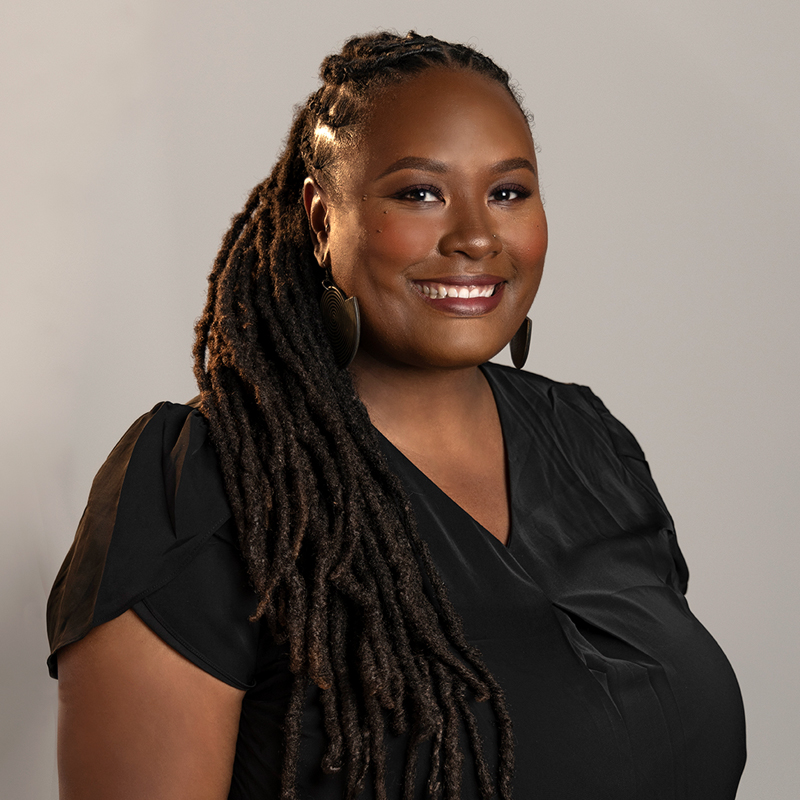
Nonprofits
Alana Henry
Alana Henry laughed when she found handwritten meeting notes from when she was a young girl helping her parents at the community group they founded. “There’s my little 9-year-old cursive signature,” she says.
As the Ivanhoe Neighborhood Council’s executive director, her role has come full circle. “Activism, volunteering, giving back is the heart at who I am,” she says, all traits she learned from her parents, Alan and Yolanda Young.
She learned additional skills while owning a career management company and being operations manager for the Young Family Farm.
Did she have to work twice as hard to prove she earned her positions despite her family name? “Yes. That’s just a fact of life. But through my insistence on being transparent and honest in daily communications it’s been a positive transaction.”
“It all starts with a code of ethics in how you conduct your personal and business lives,” she says. “I keep at the forefront what I learned from my parents—to be honest, respectful, and to really care about the people I’m serving and the community that I live in.”
While the Ivanhoe Neighborhood Council depends on volunteers for many of its programs, Henry treats it like a true not-for-profit business with a board of directors and defined leadership roles.
Yet many of the management duties fall to her. “I’m pretty adept at juggling,” she says with a laugh. For instance, grant writing takes a great deal of time. “It’s so specific,” she says, “so I spend a lot of early morning and late-night hours tackling the dozens of forms.” Despite some rejections, she’s had a lot of wins, achieving $1.5 million in grants to date.
She’s also proud of the community’s Garfield East Senior Cottages that have been developed through several phases. “We’re facing an affordable housing shortage here in Kansas City and across the nation,” she says, “so this is a huge plus for our neighborhood.” They also provide minor home repair services for seniors, making it easier for this key demographic to remain in their residences.
Addressing the needs of the entire community is at the center of what the organization does, despite its challenges. There are around 6,000 residents in all, living between 31st to 47th streets and Paseo to Prospect. Being split by 71 Highway and 39th Street, there are four quadrants.
“It’s important that we make each quadrant feel like part of one big community,” she says, “whether they’re near the Nutter Ivanhoe Community Center or not.” One way that’s done is through a robust calendar of events and programs, including music for youth, tech training for seniors, nutritional education and market day at the Young Family Farm. Her four daughters are continuing the path she began when she was a little girl: helping on harvest days, giving tours and engaging with neighbors. “These are life lessons that will take them far.”
What Henry finds most rewarding about the city she loves are the “amazing people doing work to make this city stronger.”
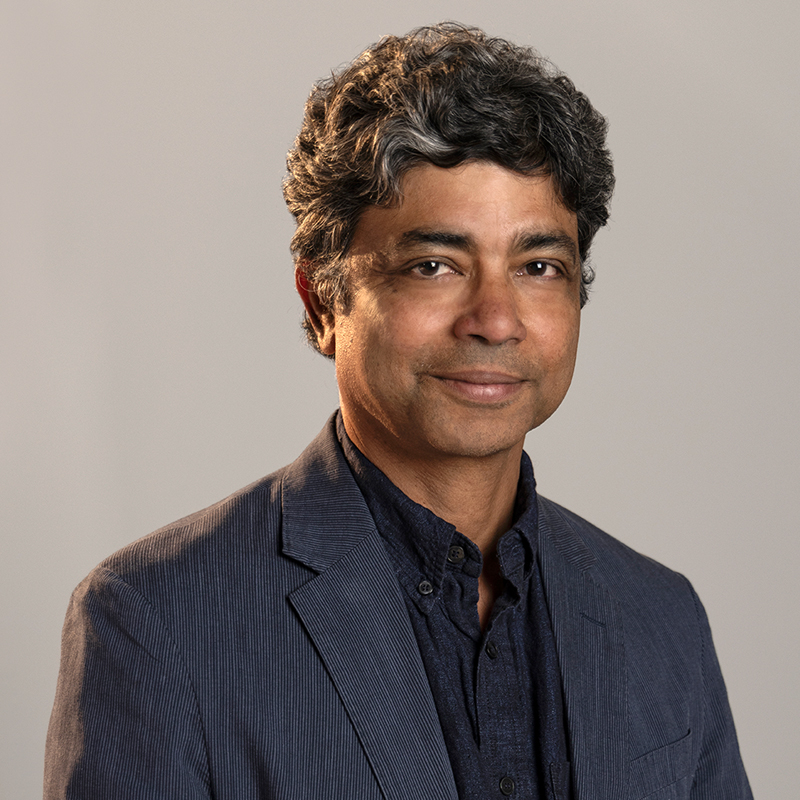
Healthcare
Dr. Kausik Si
Our first kiss. A favorite aunt’s perfume. The smell of a campground fire. Memories—good or bad—define us, are “part of who we are as humans,” according to neurologist Kausik Si. And apart from triggering an emotion, memories can mean life or death.
Take the simple fruit fly, one of the tiny beings the scientist is studying as a means to help treat brain diseases, including Alzheimer’s. “Fruit flies must remember where the food is, who to mate with, who to avoid. Consciousness, the relationship between prey and predator, which is part of every living thing, is what intrigues me the most. A fruit fly may seem so far from us, yet you can get deep inside to see how memories work.”
Of the two parts of any disease—the cause and the cure—Si’s work tackles the cause. In the case of Alzheimer’s, there have been multiple studies on proteins that clump, called amyloids. Si’s groundbreaking study, called “Tuning memory by altering amyloids,” asks what if this clumping isn’t always a bad thing?
Perhaps, he surmised, if instead of removing all the clumps, we can remove just the bad ones and keep the good ones.
He and a scientist partner earned an award from the Chan Zuckerberg Initiative, which was founded in 2015 by Facebook founder Mark Zuckerberg and his wife, Priscilla Chan.
The funding organization has the same goal as the Stowers Institute where Si works: to expand our understanding of the secrets of life and improve life’s qualities through innovative approaches to the cause, treatment, and prevention of disease.
Asking the big questions, the “what ifs” is “the beauty and joy of science,” says Si. “Finding something you would never imagine.”
As a professor of the Department of Cell Biology and Physiology at the University of Kansas School of Medicine, that’s what he tries to impart to his students. “By realizing we don’t know everything, it frees your thinking. As humans, we’re drawn to the unknown, to that element of surprise. It’s why we go to the jungle or to the moon.
“It’s the same with scientists. I try to teach the wonders of life and nature.”
Si is grateful to be associated with the institute founded by the late James E. Stowers, Jr. and his wife, Virginia Stowers. “It’s a remarkable gift to Kansas City.” He says this while overlooking a gift from another philanthropist, the Kauffman Gardens, from his office window.
It’s tied to how he describes Kansas City. “It’s a place to think, to reflect and appreciate the gift of life and nature. Before moving here, all I knew about Kansas City came from one of my favorite writers, Calvin Trillin. I soon learned there was so much more.”
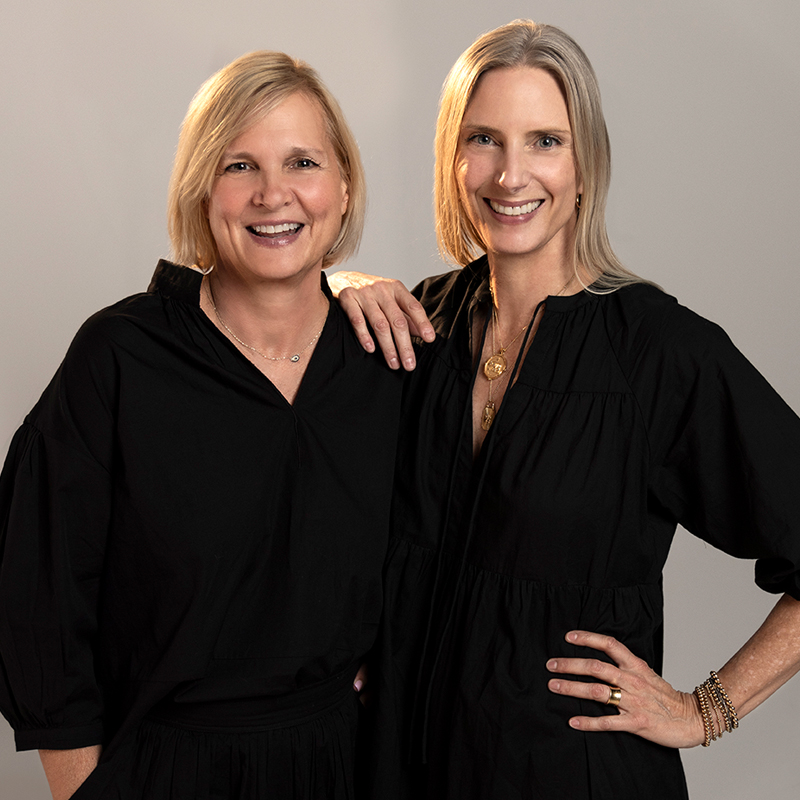
Fashion
Melanie Bolin & Lina Dickinson
It’s hard not to covet Mersea founders’ lives. Follow Bolin and Dickinson around the world and watch the business partners laugh as they oversee a photo shoot in Tulum or open bottles of Champagne to celebrate a significant number of orders, go for a gelato run in Monopoli, or dine on wood-fired pizza in Sorrento.
Their lives are a travelogue and thankfully, every item they sell—from the iconic Catalina slub tee to the Atlas dress—is ideal for packing into a carry-on bag. Versatility is at the heart of every design. Bolin says, “We want every piece to find its way into the next outfit.”
And another key element; the clothes are flattering on everyone. “That’s a conscious effort,” says Dickinson. “When we get samples in, we try them on everyone from a size 0 to 12, 14. We make adjustments to make sure they feel and look good on a variety of shapes.” And ages. No doubt somewhere right now there’s a teenager borrowing an Amalfi cap-sleeved sweater from her mom’s closet.
How does it feel when the founders see someone wearing one of their designs? “It’s thrilling,” says Dickinson. “We’ve seen our travel wrap at the Charles De Gaulle Airport in Paris and, closer to home, at Earl’s Premiere in Brookside.” Bolin adds, “It’s hard not to run up to them and say thanks!”
The wildly popular line began in 2013 when the two businesswomen brought hand-poured candles and the now iconic travel wrap to the American Royal Tablescapes event. Women loved the scents and the chic packaging and the brand took off. “Wholesale came first,” recalls Dickinson, “then trade shows before we started getting into retail stores.”
In 2016 and 2017, the duo realized they wanted to cater to their customers directly. With a redesigned website, they were able to share their love of travel with images of photo shoots. Dining alfresco in Granada, Spain, meeting with the market bag partners in Morocco—all while encouraging customers to create their own bucket lists of exotic places to explore.
A little more than a decade after selling its first candle, the Mersea brand has found its way into our wardrobes, suitcase, and nightstand.
Product development continues as do travel plans; Portugal in September, then Mexico City. So, what do they wear while traveling? “I’m usually in one of our Catalina sweaters,” says Bolin, and Dickinson is a devotee of the denim line. “Our jeans are just so great,” she says. “We launched the line about a year ago. They stretch, so I love them for long flights or just hanging out at home.”
Dickinson even offered a scoop for an upcoming item. “We’re adding knit pants to go with our tops this fall, starting with black and navy and a gorgeous hazelnut color.” “We’re really pumped about this,” adds Bolin. “Our Catalina lover will feel like she’s wearing a cute little set.”
So how do these two partners describe Kansas City to people they meet around the world? “I always say they’re the friendliest people who are very supportive and loyal,” says Dickinson. “There’s also a level of pride and tremendous work ethic here,” says Bolin. “We have awesome women in our office. There’s just an extra spark in Kansas City.”


